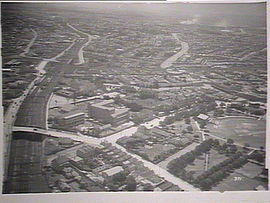Lewisham, New South Wales
|
Lewisham Sydney, New South Wales |
|||||||||||||
|---|---|---|---|---|---|---|---|---|---|---|---|---|---|

Aerial photograph of Lewisham in the 1930s showing from left, the railway line, Lewisham Hospital and Petersham Park
|
|||||||||||||
| Population | 2,927 (2011 census) | ||||||||||||
| Postcode(s) | 2049 | ||||||||||||
| Location | 8 km (5 mi) south-west of Sydney CBD | ||||||||||||
| LGA(s) | Inner West Council | ||||||||||||
| State electorate(s) | |||||||||||||
| Federal Division(s) | Grayndler | ||||||||||||
|
|||||||||||||
Lewisham is a suburb in the Inner West of Sydney, in the state of New South Wales, Australia. Lewisham is located 8 kilometres south-west of the Sydney central business district, in the local government area of Inner West Council. The postcode is 2049. Lewisham is surrounded by the suburbs of Petersham, Dulwich Hill, Summer Hill, Haberfield and Leichhardt.
Lewisham took its name in 1834 from the estate of Joshua Frey Josephson, a German-born businessman who would later become mayor of Sydney. The estate was named after the London borough of Lewisham, which means Leofsa's village or manor.
The original residents of the Lewisham area were the Cadigal clan of the Darug tribe. Artefacts found near the Cooks River indicate at least 7,000 years of habitation in the local area. When the First Fleet arrived in 1788, the settlers set up camp in the middle of Cadigal territory. While the first governor Arthur Phillip tried to establish cordial relations with the Cadigals and their neighbours, the two groups were competing for the same food sources and tensions inevitably developed. In 1789, a smallpox epidemic wiped out the majority of the Cadigals. By 1809, all the land within Lewisham had been granted.
...
Wikipedia
